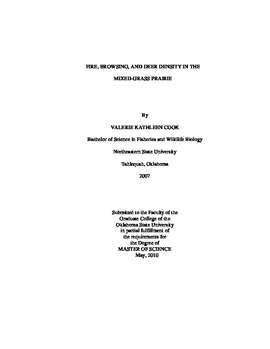| dc.contributor.advisor | Hickman, Karen R. | |
| dc.contributor.author | Cook, Valerie Kathleen | |
| dc.date.accessioned | 2014-04-15T21:59:39Z | |
| dc.date.available | 2014-04-15T21:59:39Z | |
| dc.date.issued | 2010-05-01 | |
| dc.identifier.uri | https://hdl.handle.net/11244/9163 | |
| dc.description.abstract | White-tailed deer are keystone herbivores that have been shown to reduce reproductive success, abundance, diversity, distribution, and survival of plants in the tallgrass prairie. I assessed concerns that deer browsing reduced food resources for northern bobwhites by reducing seed production of important grass and forb species. I also compared results of deer browse and camera survey methods and combined the 2 methods to develop a management (harvest) application. In 2008-2009, I conducted fall and winter infra-red triggered camera surveys to estimate absolute (ha/deer) density and winter browse surveys to estimate relative (above, at, or below carrying capacity) deer density on McBride pasture in Woods County, and the Cross Timbers Experimental Range (CTER) in Payne County, Oklahoma. I quantified effects of fire and browsing on growth and reproduction of one grass and three forb species (Scribner's panicum, erect dayflower, lambsquarters, and western ragweed) at McBride. In June-September 2008, I measured mean stem length and biomass, sexual reproductive effort, and percent of browsed and reproductive stems per 1 m 2 plot from within deer exclosures, deer and rabbit exclosures, and surrounding browsed vegetation in burned and unburned portions of McBride pasture. Deer density on McBride was one deer/4.3 ha with a recruitment rate of 0.3 fawns/doe, which browse surveys indicated to be exceeding carrying capacity. Deer density on CTER was one deer/5.4 ha with a recruitment rate of 0.9 fawns/doe, which browse surveys indicated to be within carrying capacity. Camera survey population data supported browse survey findings and indicated CTER was the more productive site of the 2 habitats. I calculated 17 bucks and 71 does needed to be harvested from McBride to achieve a desirable sex ratio and bring the population to within carrying capacity of the site. Herbivory at McBride was attributed to deer rather than rabbits or the combination of both species. Browsing ranged from zero to 100% of stems per plot. Species' growth responses varied considerably, but sexual reproductive effort (seed production) was 1.3 - 5.6 higher for plants in burned treatments. Though browse surveys indicated deer density on McBride pasture exceeded carrying capacity, browsing did not reduce food resources for bobwhites. However, fire increased plant reproductive effort. | |
| dc.format | application/pdf | |
| dc.language | en_US | |
| dc.publisher | Oklahoma State University | |
| dc.rights | Copyright is held by the author who has granted the Oklahoma State University Library the non-exclusive right to share this material in its institutional repository. Contact Digital Library Services at lib-dls@okstate.edu or 405-744-9161 for the permission policy on the use, reproduction or distribution of this material. | |
| dc.title | Fire, Browsing, and Deer Density in the Mixed-Grass Prairie | |
| dc.type | text | |
| dc.contributor.committeeMember | Elmore, Dwayne | |
| dc.contributor.committeeMember | Guthery, Fred S. | |
| osu.filename | Cook_okstate_0664M_10740.pdf | |
| osu.college | Agricultural Sciences and Natural Resources | |
| osu.accesstype | Open Access | |
| dc.description.department | Department of Natural Resource Ecology and Management | |
| dc.type.genre | Thesis | |
| dc.subject.keywords | browsing | |
| dc.subject.keywords | deer density | |
| dc.subject.keywords | fire | |
| dc.subject.keywords | oklahoma | |
| dc.subject.keywords | seed production | |
| dc.subject.keywords | white-tailed deer | |
